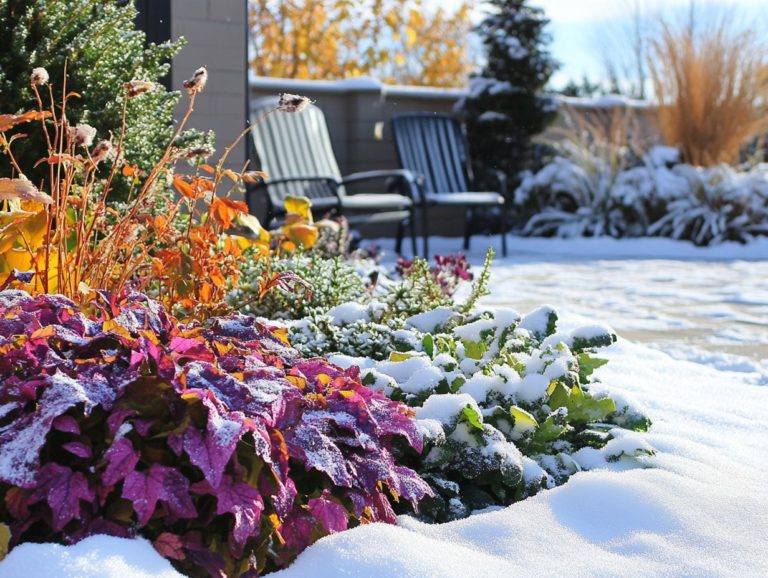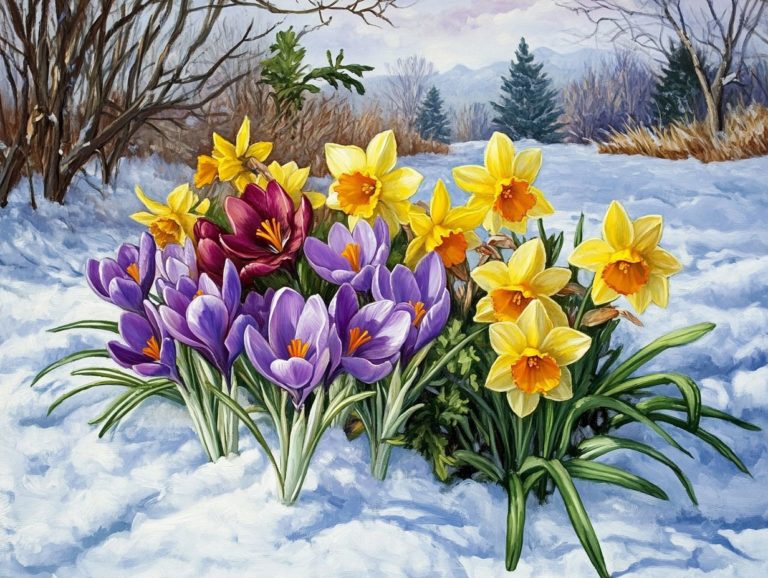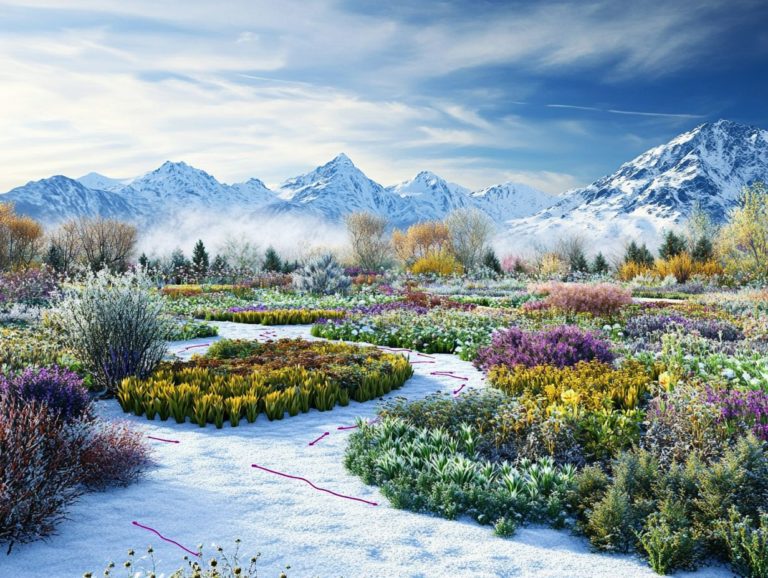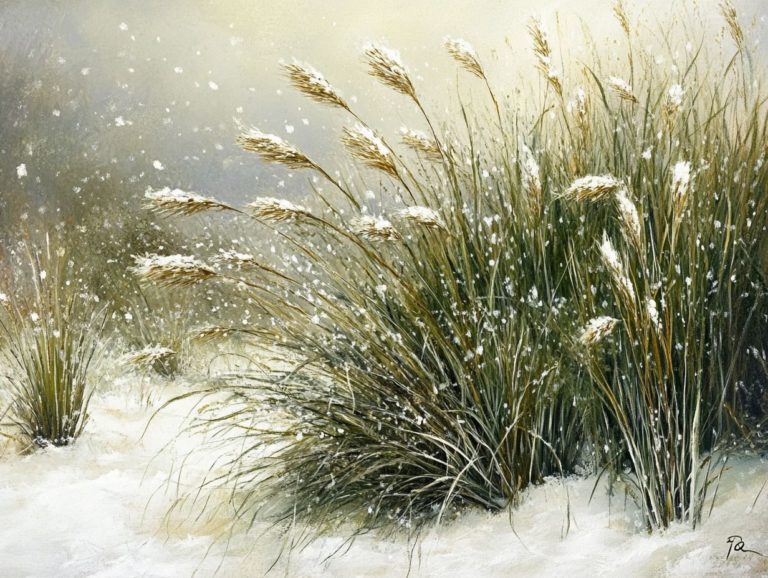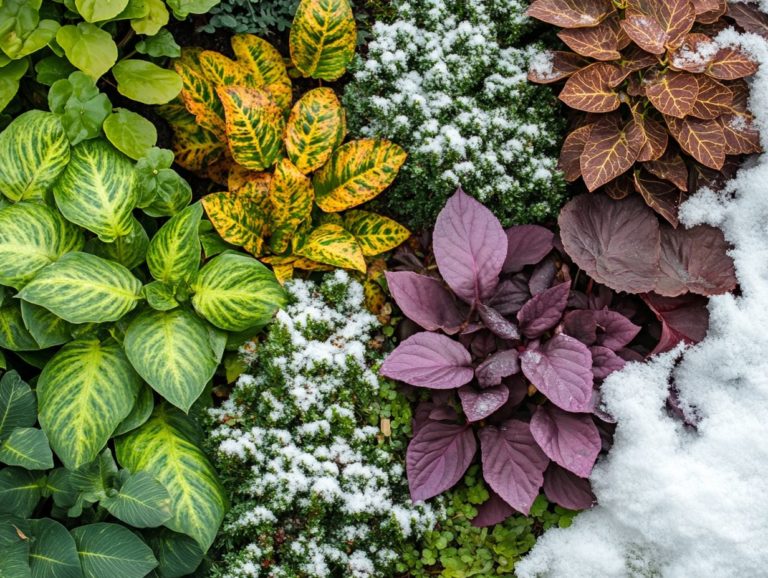Best Indoor Plants for Cold Climates
Bringing greenery into your home can be a delightful way to invigorate any space, but selecting the right plants for cold climates is essential.
Discover 15 amazing indoor plants that thrive in cold temperatures! From the resilient Snake Plant to the lush Monstera, each choice offers the perfect opportunity to infuse your living area with a touch of nature.
Get ready to discover the amazing benefits of indoor plants, including essential gardening tips. You ll gain insights on creating an ideal environment and learn about common care pitfalls to avoid.
Dive in and discover how to cultivate a vibrant indoor garden, regardless of the chill outside!
Contents
- Here are your must-know tips:
- 1. Snake Plant
- 2. Pothos
- 3. Spider Plant
- 4. Chinese Evergreen
- 5. Peace Lily
- 6. ZZ Plant
- 7. Philodendron
- 8. English Ivy
- 9. Jade Plant
- 10. Aloe Vera
- 11. Rubber Plant
- 12. Monstera
- 12. Dieffenbachia
- 13. Dracaena
- 14. Norfolk Island Pine
- 15. Calathea
- What Are the Benefits of Having Indoor Plants in Cold Climates?
- How Can One Create the Ideal Environment for Indoor Plants in Cold Climates?
- What Are the Common Mistakes When Caring for Indoor Plants in Cold Climates?
- What Are the Signs of Stress in Indoor Plants in Cold Climates?
- How Can One Prevent Pests and Diseases in Indoor Plants in Cold Climates?
- Frequently Asked Questions
Here are your must-know tips:
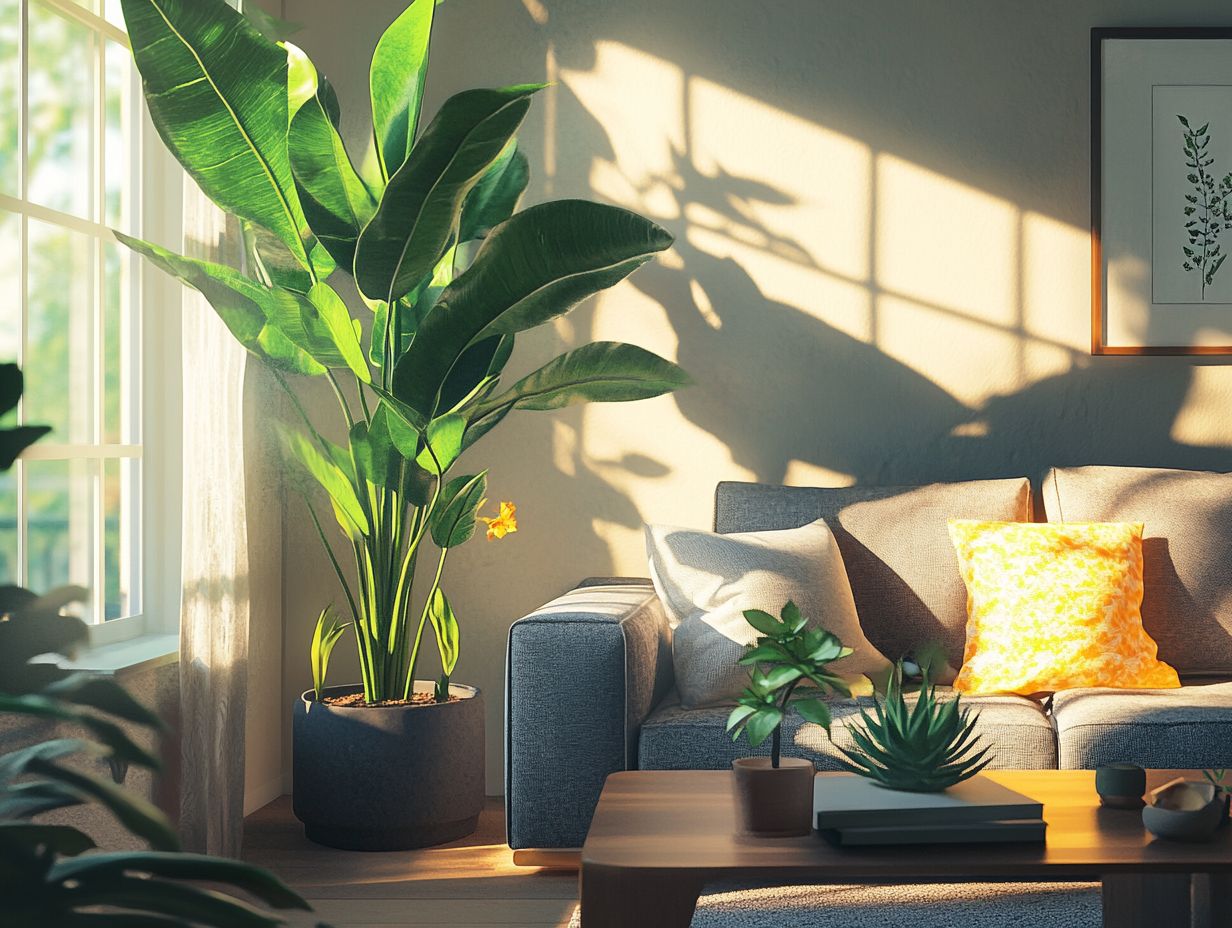
- Choose hardy houseplants for cold climates, including low-maintenance plants like Snake Plants, Pothos, and Spider Plants.
- Creating a humid environment and avoiding overwatering are essential for the health of indoor plants in cold climates.
- Properly monitoring and caring for indoor plants can prevent common issues such as stress, pests, and diseases in cold climates.
1. Snake Plant
The Snake Plant, also known as Sansevieria, is truly a standout among indoor plants. Its resilience makes it perfect for cold, drafty rooms! This hardy plant has remarkable cold tolerance and low maintenance needs, capturing the hearts of gardening enthusiasts and homeowners alike.
These plants thrive in low-light conditions, making them perfect for those nooks and crannies that receive minimal sunlight. They don t require much watering; their drought-resistant nature allows them to store moisture in their leaves, adapting effortlessly to your occasional forgetfulness.
This unique ability not only makes them forgiving for those new to plant care but also enhances their air-purifying properties, helping to clean the air by removing toxins. Providing bright, indirect light can certainly encourage growth, but their incredible hardiness means they ll continue to flourish even in less-than-ideal environments.
2. Pothos
Pothos, also known as Epipremnum aureum, is a fantastic indoor plant that thrives splendidly in cold environments. It can handle the cold easily and excels as an air-purifying marvel, making it a sought-after addition to your home or office.
With several captivating varieties, like Golden Pothos, Marble Queen, and Neon Pothos, each boasts unique leaf patterns and colors, adapting effortlessly to various growth conditions. Those trailing vines can extend multiple feet, making them ideal for hanging baskets, elegant shelving, or as a striking centerpiece on your tabletop.
Caring for this plant in cooler climates requires a few thoughtful adjustments, such as maintaining optimal indoor temperatures and avoiding drafts. Their impressive ability to filter harmful pollutants not only elevates indoor air quality but also fosters a soothing environment, promoting both well-being and productivity in your space.
3. Spider Plant
The Spider Plant, with its striking green and white striped leaves, thrives in different conditions, making it a favorite among plant lovers. It’s celebrated for its low maintenance, making it perfect whether you’re a novice or a seasoned gardener.
This resilient species flourishes even in drafty rooms where temperatures can fluctuate, showcasing its impressive adaptability. Propagation is simple; it spreads through its charming baby spiderettes that dangle from the mother plant, offering you a delightful opportunity to expand your collection or share the joy with friends.
In terms of care, simply provide bright, indirect sunlight and water it occasionally to keep it vibrant. Meanwhile, its air-purifying qualities work quietly in the background, diligently removing toxins from your space. Its cascading leaves bring a stylish touch to any indoor area, effortlessly enhancing the overall aesthetic.
4. Chinese Evergreen
The Chinese Evergreen, or Aglaonema, stands out for its stunning foliage and remarkable resilience. This prized indoor plant is cold-tolerant and thrives in lower temperatures, adding a vibrant touch to your space. It s perfect if you’re seeking hardy houseplants for less-than-ideal growing conditions.
You ll find numerous varieties of Chinese Evergreen, each showcasing unique patterns and hues, ranging from deep greens to striking silvers and reds. These plants excel in low-light survival, making them ideal for dimly lit rooms where other plants might struggle. They enjoy indirect sunlight, which is light that doesn t shine directly on the plant, but their adaptability allows them to flourish with minimal care.
Their air-purifying abilities effectively filter out common indoor pollutants, contributing to a healthier living environment. With their lush, ornamental leaves, Chinese Evergreens not only elevate your interior aesthetics but also serve a practical purpose, beautifully marrying elegance with functionality. With the right care, these plants will thrive, bringing life to your indoor spaces!
5. Peace Lily
The Peace Lily, known scientifically as Spathiphyllum, is not just a beautiful addition to your indoor space with its elegant white blooms; it s also a cold-tolerant marvel celebrated for its air-purifying abilities. This makes it an exceptional choice for enhancing indoor air quality, especially in cooler climates.
To ensure it thrives, provide indirect sunlight, which is bright but filtered exposure. Be cautious with watering; overdoing it can spell trouble. Allow the top inch of soil to dry out before giving it another drink.
Keep an eye out for signs of stress, like drooping leaves or yellowing, as these might signal a need for a shift in care. With just the right balance of light and water, your Peace Lily will flourish, diligently absorbing pollutants and releasing fresh oxygen. It thrives in cooler temperatures, making it suited for a variety of home environments while contributing to a healthier atmosphere.
6. ZZ Plant
The ZZ Plant, or Zamioculcas zamiifolia, is a true gem in the world of indoor greenery. Its striking glossy leaves and impressive cold tolerance make it an ideal choice for those who appreciate low-maintenance plants that flourish in less-than-ideal conditions. You’ll love how easy it is to enjoy this stunning plant!
This resilient beauty thrives in a range of lighting conditions, from low to bright indirect light. While it can handle low light, placing it in an area with indirect sunlight will enhance its vibrant foliage, giving your space a refreshing lift.
In terms of watering, think of it as a delicate dance. The ZZ Plant prefers infrequent watering, often requiring the soil to dry out completely between sessions. This drought resistance makes it an excellent choice for busy individuals, allowing you to enjoy the beauty of the plant without the constant worry of wilting.
7. Philodendron
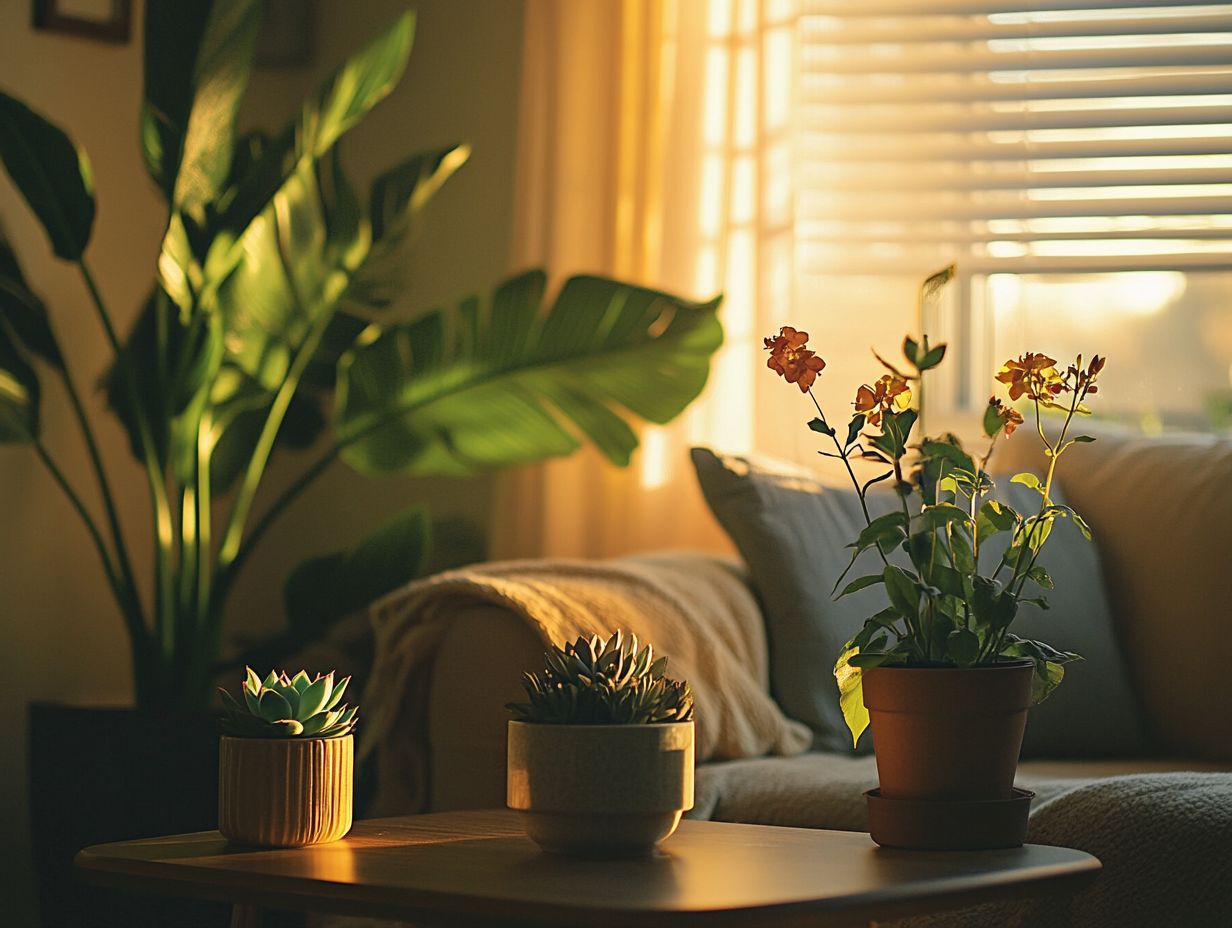
Philodendrons are among the most sought-after cold-tolerant indoor plants, celebrated for their lush foliage and remarkable adaptability. They’re perfect for anyone looking for low-maintenance options that enhance their space and thrive in various indoor conditions.
With an array of varieties available, from the charming heartleaf Philodendron to the more dramatic selloum, you ll find plenty of choices to complement any decor style. Each type has its own unique care requirements, so you can enjoy these beauties even with limited gardening experience. Generally, regular watering and indirect sunlight will keep them thriving, but their adaptability makes them resilient in cooler temperatures.
By placing these plants strategically throughout your space, you elevate the indoor aesthetic while bringing a touch of nature indoors, transforming any room into a more inviting and vibrant sanctuary. For those in colder areas, consider the best plants for shade gardens in cold climates and transform your home into a vibrant oasis!
8. English Ivy
9. Jade Plant
English Ivy, or Hedera helix, is the quintessential cold-tolerant indoor plant that infuses any room with elegance. Its hardy nature and ability to flourish in cooler temperatures make it an outstanding choice for anyone looking to elevate their indoor space with a touch of greenery.
Beyond its visual charm, English Ivy thrives in bright, indirect light. It s adaptable enough to flourish in lower light conditions, making it suitable for various indoor environments. To achieve optimal growth and lush foliage, aim to maintain moderately high humidity levels; this means keeping the air around the plant slightly moist.
One of its most impressive traits is its ability to clean the air; it can filter out toxins and enhance indoor air quality, contributing to your overall well-being.
This remarkable adaptability allows English Ivy to seamlessly integrate into diverse settings, from cozy homes to bustling offices, offering both aesthetic beauty and health benefits.
10. Aloe Vera
Aloe Vera, a celebrated succulent, isn t just appreciated for its medicinal properties; its cold-tolerant nature makes it an ideal indoor plant that requires minimal care while offering both aesthetic charm and functional benefits, particularly in cooler climates.
This tough plant loves bright, indirect sunlight too much direct light can scorch its leaves. Watering is equally vital; letting the soil dry out completely between waterings mimics its natural arid habitat. A thorough soak, followed by a dry period, keeps the roots healthy and helps prevent rot.
Aloe Vera is a must-have it soothes burns and hydrates skin like no other! This makes it a wonderful addition to your indoor succulent collection, enriching your living space while positively impacting your overall well-being.
11. Rubber Plant
The Rubber Plant, or Ficus elastica, stands out as a coveted cold-tolerant indoor plant that infuses elegance into your home and showcases remarkable resilience. It s a top choice for those seeking hardy houseplants that thrive even in less-than-ideal conditions.
With various captivating varieties at your disposal, including the popular variegated form flaunting its striking cream and green leaves, or the more dramatic burgundy leaf type, you ll find something to perfectly suit your aesthetic preferences.
Caring for these plants is a breeze; they flourish in bright, indirect light but can adapt to low-light situations, requiring only the occasional sip of water. Their impressive ability to clean the air adds to their charm, effectively eliminating toxins and turning your space into a healthier environment, whether at home or in the office.
Whether you re a seasoned plant aficionado or just stepping into the world of indoor gardening, incorporating Rubber Plants into your decor will undoubtedly elevate both your style and air quality with effortless grace. Bring one home today!
12. Monstera
Monstera, with its iconic split leaves, isn t just a feast for the eyes; it flaunts impressive cold tolerance, making it a top pick for anyone seeking hardy houseplants that can thrive in a variety of indoor climates without demanding much attention.
This remarkable plant truly shines in bright, indirect sunlight, allowing its striking leaves to flourish while protecting them from the harshness of direct sun. It s vital to remember that well-draining soil and a consistent watering schedule are key; letting the top inch dry out between waterings promotes healthy growth.
But the Monstera isn t just about looks; its lush foliage actively purifies indoor air, adding real value to your home. With its exotic allure, it creates a vibrant atmosphere that elevates the overall ambiance of any space you choose to enhance. Consider adding one to your indoor garden today!
12. Dieffenbachia
Dieffenbachia, commonly known as Dumb Cane, is a truly captivating indoor plant that can withstand cooler conditions. With its striking foliage and minimal care requirements, it has become a preferred choice for both novice and seasoned gardeners eager to infuse their spaces with greenery.
For optimal growth, this plant thrives in bright, indirect light. It also has the remarkable ability to adapt to lower light conditions, enhancing its appeal as a versatile houseplant.
In terms of watering, exercise caution allow the top inch of soil to dry out between waterings. This not only prevents overwatering but also keeps the roots healthy and thriving.
Dieffenbachia also purifies the air effectively, significantly enhancing indoor air quality by eliminating toxins and fostering a fresher atmosphere. Its resilience and adaptability make it an excellent addition to any environment, whether at home or in the office, offering both beauty and usefulness.
13. Dracaena
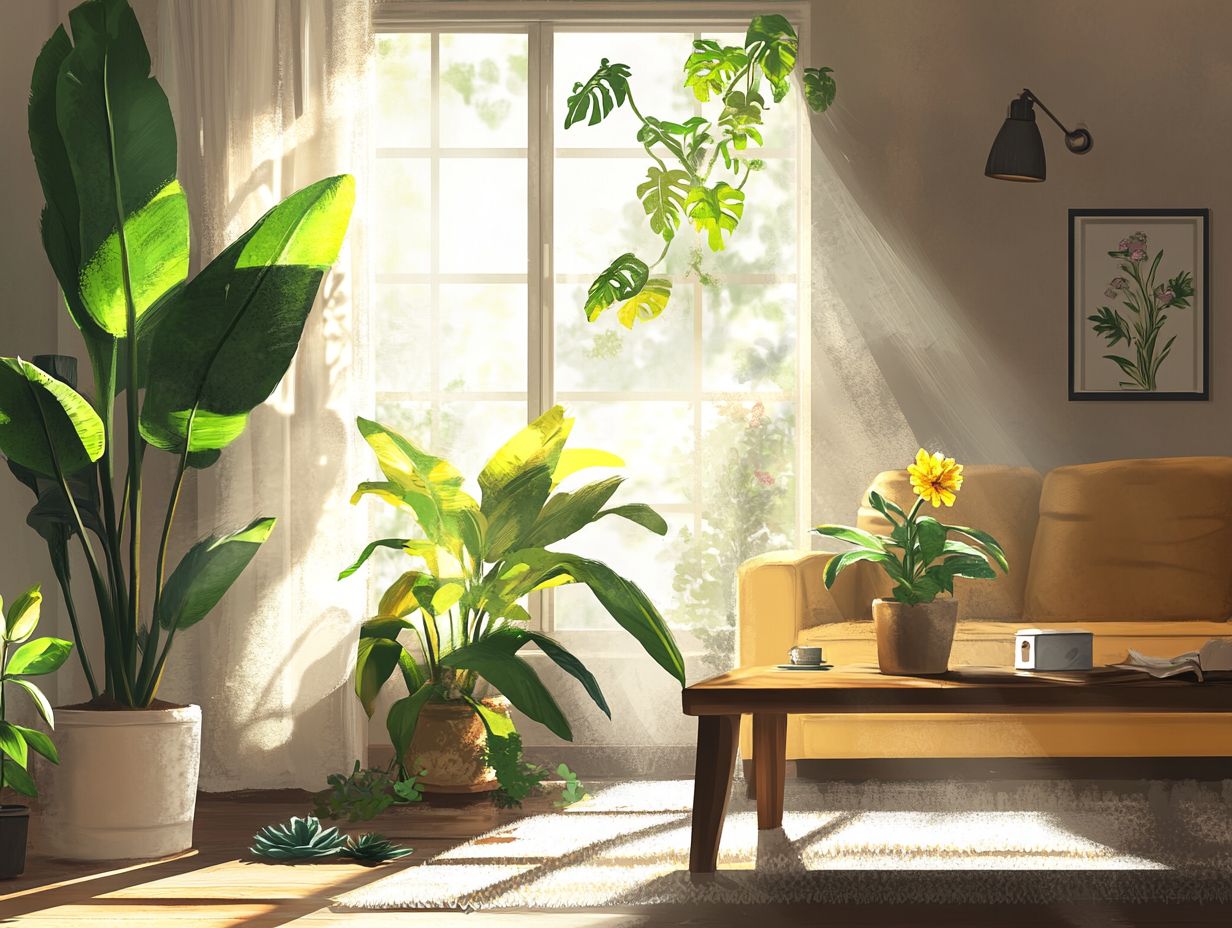
Dracaena, especially Dracaena marginata, stands out as a favored cold-tolerant indoor plant. It is celebrated for its striking appearance and remarkable adaptability to a range of indoor conditions. For those looking to expand their gardening skills, exploring the best plants for cold-climate rooftop gardens can lead to excellent choices that require minimal maintenance.
Beyond marginata, the Dracaena family boasts an array of species, including Dracaena trifasciata and Dracaena fragrans. Each contributes its own unique flair and character to your indoor spaces. These plants thrive in temperatures between 60 and 75 degrees Fahrenheit, making them perfectly suited for cooler environments that may challenge less resilient species.
Not only do they elevate the visual appeal of any room, but they also excel at purifying the air, fostering a healthier living atmosphere.
With simple care routines like moderate watering and exposure to indirect sunlight you can help these plants flourish. Enjoy their stunning foliage without any extensive effort!
14. Norfolk Island Pine
The Norfolk Island Pine stands out as a uniquely cold-tolerant indoor plant that resembles a small evergreen tree. It adds a touch of charm to your home while proving to be remarkably hardy. If you’re in search of plants for windy cold-climate gardens that can thrive in cooler conditions, this plant is a fantastic choice!
It thrives best in bright, indirect light but is adaptable enough to flourish in moderate lighting as well, making it a versatile choice for various indoor spaces.
Regular watering is essential for its health; keep the soil slightly moist by allowing the top inch to dry out between waterings. Be mindful overwatering can lead to root rot, a condition caused by excess moisture in the soil, so paying attention to moisture levels is essential.
With its symmetrical shape and lush, green branches, this plant enhances your interior aesthetics and elevates the overall ambiance of any room. It serves as a delightful focal point in living areas or offices, effortlessly bringing a touch of nature indoors.
15. Calathea
Calathea, with its beautifully patterned leaves, is a striking indoor plant that enhances the aesthetic of your space. It requires relatively low maintenance, making it a highly desirable choice for any plant enthusiast.
To truly appreciate the allure of this remarkable plant, it’s essential to provide the right care conditions, especially regarding humidity and light. Calathea thrives in high humidity ideally around 50-60% and prefers indirect light, as direct sunlight can scorch its stunning foliage.
Beyond its captivating visual appeal, marked by intricate designs and vibrant hues, Calathea actively improves indoor air quality by filtering out toxins. If you’re looking to create a serene and inviting atmosphere indoors, incorporating this unique plant can undoubtedly make a noteworthy difference.
What Are the Benefits of Having Indoor Plants in Cold Climates?
Having indoor plants in cold climates brings a wealth of benefits. You’ll not only improve air quality using plants that clean the air, but also elevate the aesthetic allure of your home. For inspiration, consider the top 10 low-maintenance plants for cold climates to transform any chilly, drafty room into a cozy sanctuary, all while employing effective gardening tips to nurture your indoor foliage through the winter months.
Consider resilient options like the snake plant or tough pothos. These leafy companions thrive in lower light conditions and diligently absorb toxins such as formaldehyde and benzene, making your indoor air significantly healthier.
Research indicates that engaging with greenery can greatly lower your stress, uplift your mood, and even enhance productivity especially crucial during the dreary winter months when natural sunlight is in short supply.
By incorporating such vibrant greenery into your living space, you can create a relaxing space that helps you unwind, no matter how cold it gets outside.
How Can One Create the Ideal Environment for Indoor Plants in Cold Climates?
Creating the ideal environment for your indoor plants in cold climates requires a keen understanding of their specific needs. Make sure you have the right light, humidity, and temperature while choosing the right plants for cold climates that can truly thrive in challenging conditions.
Managing temperature is crucial; aim to keep your indoor settings between 65 F and 75 F, as fluctuations can stress many plants. Maintaining humidity levels around 40-60% will help you avoid issues like leaf drop and disease, so consider using a humidifier or pebble trays to achieve that perfect balance.
Choosing the right light exposure is equally important. For example, sun-loving species will bask in a south-facing window, while shade-tolerant varieties will thrive in filtered light. By customizing your care to meet your plants’ unique preferences, you can cultivate a flourishing indoor garden, even in the heart of winter.
What Are the Common Mistakes When Caring for Indoor Plants in Cold Climates?
When caring for indoor plants in cold climates, it s easy to fall into common traps like over-watering, ignoring humidity levels, or placing your plants in less-than-ideal light conditions. These missteps can seriously hinder growth and stress your greens, underscoring the importance of following effective gardening tips specifically designed for hardy houseplants, including popular choices like the ZZ plant and cast iron plant.
Understanding each plant’s unique needs is crucial. Some plants are sun worshippers, thriving in direct sunlight, while others prefer a more shaded, filtered light experience, ideal for many houseplants in cold drafty rooms.
Incorporating humidity trays or using a humidifier can work wonders for plant health during those dry winter months. It s also vital to adjust your watering habits for air-purifying plants like the Snake Plant and Dracaena marginata according to the season; roots can succumb to rot in overly wet soil when temperatures dip. Allow the top inch of soil to dry out before you think about rewatering.
By being mindful of these changes, you can cultivate a thriving indoor garden, even in the midst of the chill.
What Are the Signs of Stress in Indoor Plants in Cold Climates?
Recognizing the signs of stress in your indoor plants during those chilly months is vital for their well-being. Look for telltale signs like yellowing leaves, wilting, or stunted growth common signs in sago palm and maidenhair ferns. These signals require prompt care to help your plants thrive.
Beyond these obvious symptoms, you may notice brown leaf tips, reduced moisture in the soil, a critical issue for geraniums and jade plants, and a general lack of vitality, all of which indicate that your plant is not thriving. If you’re nurturing greenery in less-than-ideal temperatures, it’s essential to routinely check for drafts and ensure that humidity levels are just right. Providing adequate warmth and perhaps investing in a humidifier can significantly improve your plants’ living conditions.
Carefully monitoring your watering schedule and opting for well-draining soil can alleviate some of those stress signals, promoting a healthier and more resilient indoor garden.
How Can One Prevent Pests and Diseases in Indoor Plants in Cold Climates?
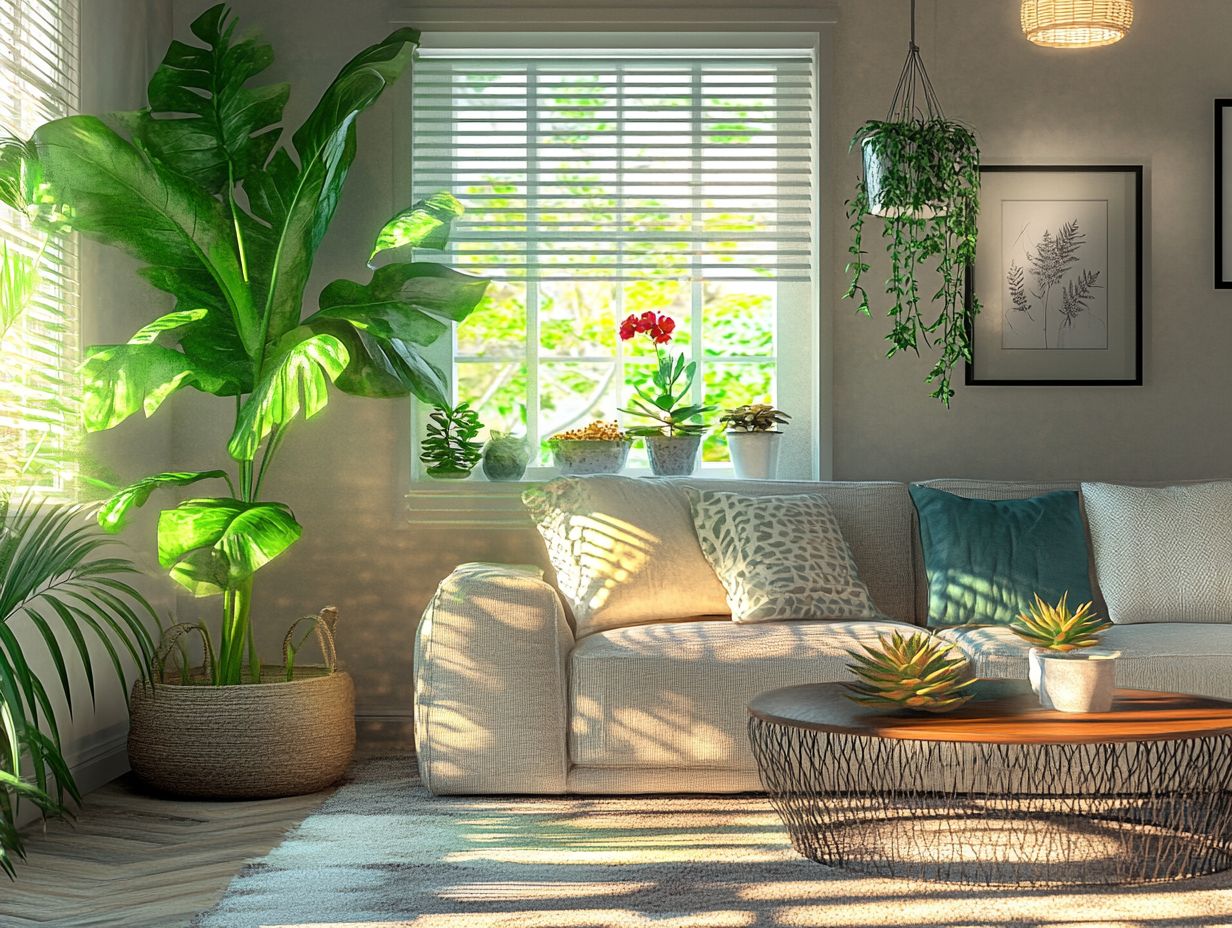
Preventing pests and diseases in your indoor plants during colder months demands attention. Regular inspections and maintaining the right humidity levels to help plants like cyclamen and dwarf citrus thrive are essential strategies.
Cleanliness plays a crucial role. Wiping down the leaves will boost photosynthesis and keep pests at bay by removing dust and debris.
Incorporating preventive measures such as using neem oil, a natural insect repellent, to protect your jade plant and snake plant will shield your plants from nuisances like spider mites and aphids. These pests can threaten the health of your houseplants. Additionally, ensuring proper drainage and avoiding overwatering are key to preventing root rot. Regularly changing potting soil that meets the needs of air-purifying plants can significantly mitigate fungal diseases, emphasizing the need for proper care.
By embracing these practices, you create a thriving atmosphere for your plants, safeguarding their health throughout the year.
Frequently Asked Questions
What are the best indoor plants for cold climates?
Some of the best indoor plants for cold climates include Peace Lily, Snake Plant, Chinese Evergreen, and hardy houseplants like Geraniums and the ZZ Plant. For more information on maintaining these plants, check out our guide on how to care for indoor plants in cold climates.
Can these plants survive in low temperatures?
Absolutely! These plants thrive in chilly conditions and are perfect for colder climates.
Do these plants require special care in cold climates?
While these plants are hardy, it is important to keep them away from drafty windows or doors to prevent damage from cold air. Regular watering and proper lighting are also crucial for their growth.
Are these plants suitable for small spaces?
Yes, most of these plants, including ZZ Plant and Dracaena, are compact and do well in smaller spaces, making them perfect for apartments or small homes in cold climates. For more options, check out sustainable plant choices for cold climates.
Do these plants have any health benefits?
Yes, many of these air-purifying plants have properties that can improve indoor air quality, making them beneficial for overall health especially in colder climates when homes are sealed during winter.
Are these plants safe for pets?
Yes, plants like the cast iron plant and snake plant are pet-friendly and non-toxic, making them a great choice for indoor gardens. For more options, consider choosing plants for cold-climate containers in homes with pets.


